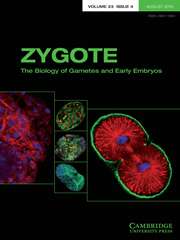No CrossRef data available.
Article contents
Comparison of CellRox green fluorescence upon thawing on in vitro Bos taurus and Bos indicus embryos cryopreserved by slow freezing or vitrification
Published online by Cambridge University Press: 18 September 2024
Summary
The aim of this study was to compare the levels of reactive oxygen species (ROS) in Bos taurus and Bos indicus in vitro embryos cryopreserved using either slow freezing or vitrification. Embryos were divided into four groups based on subspecies and freezing method: Bos indicus slow freezing (BiSF; n = 8), Bos indicus vitrification (BiVT; n = 10), Bos taurus slow freezing (BtSF; n = 9), and Bos taurus vitrification (BtVT; n = 6). After thawing, the embryos were incubated with CellRox Green and images were obtained using a confocal microscope. The fluorescence intensity of each cell was measured and expressed as arbitrary units of fluorescence (auf) and compared using a multiple regression and unpaired t-test with α = 0.05. Results showed that subspecies and the freezing method significantly affected auf (P < 0.001; R2 = 0.1213). Bos indicus embryos had higher auf than Bos taurus embryos, whether frozen by slow freezing (67.05 ± 23.18 vs 51.30 ± 16.84, P < 0.001) or vitrification (64.44 ± 23.32 vs 47.86 ± 17.53, P < 0.001). Slow freezing induced higher auf than vitrification in both Bos taurus (51.30 ± 16.84 vs 47.86 ± 17.53, P < 0.001) and Bos indicus (67.05 ± 23.18 vs 64.44 ± 23.32, P < 0.014). In conclusion, Bos taurus embryos had lower ROS levels when frozen using vitrification, while Bos indicus embryos had consistent ROS patterns regardless of the freezing method. However, Bos indicus embryos frozen by slow freezing tended to have a higher number of cells with elevated ROS levels.
- Type
- Research Article
- Information
- Copyright
- © The Author(s), 2024. Published by Cambridge University Press



